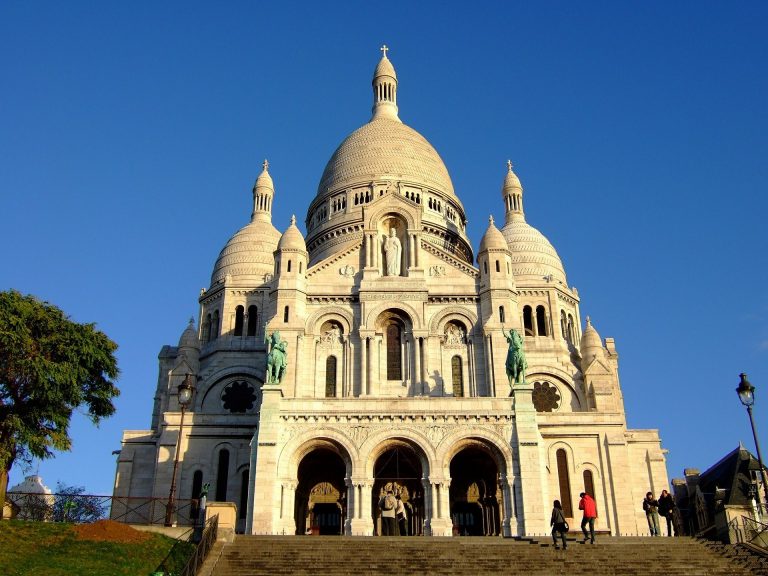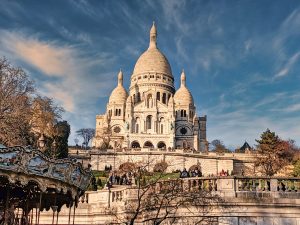It is one of the icons of Paris, perched up on the hilltop of Montmartre, overlooking the city. What’s behind Sacre Coeur history? Its unique architecture and location makes it stand out above the City of Light. Sacre Coeur has now become the most visited religious monument in Paris due to the closure of Notre Dame Cathedral.
2019 marks 100 years since the completion of the basilica, but do you know the interesting history of Sacre Coeur and the meaning behind it?
The history & stories behind Paris’ famous hilltop
Long before Sacre-Coeur, Montmartre had always been a place of worship. During the Gallo-Roman era the area of Montmartre was known as Mont Martis, which meant the mount of Mars. The Romans had a temple dedicated to Mars around the site where Sacre-Coeur stands today.
Another reason why Montmartre is religiously significant is because Saint Denis, the first bishop of Paris and an early Christian martyr, was decapitated on the hilltop in 250 AD by the Romans. Legend states that Saint Denis picked up his severed head, washed it in a fountain, and then carried it all the way to the spot where the Basilica of Saint Denis now stands. The name of the area then changed from Mont de Mars to Mont de Martyrs, which then became Montmartre.
In the 12th century, the church Saint Pierre de Montmartre was built on the site, as well as a Benedictine Abbey. The Abbey was destroyed during the French Revolution in 1790. That same year, Montmartre became a Commune. It wasn’t until 1860 that Montmartre was annexed and became part of the city of Paris. However, the area always retained its small-village like atmosphere and character as being separate from the rest of Paris.
This is why, in 1871, Montmartre was the location of the first insurrection of the Paris Commune following the defeat of France in the Franco-Prussian war. During the war, the French army had stored canons on the top of the hill of Montmartre. On March 18th 1871 soldiers from the French army tried to confiscate the cannons, yet they were met with violence from the radicalised National Guard. The National Guard captured and killed French Army generals and then installed a revolutionary government which would last for two months. Towards the end of the commune, in what is known as “The Bloody Week”, there was heavy fighting between the National Guard and the French army in Montmartre. As a result of the Paris Commune thousands of Parisians were left dead and both the Tuileries Palace and Hotel de Ville had been burned down.
In 1873 it was decided that a basilica would be built on the location as a gesture of repentance, to atone for the sins of the Paris Commune, as well as for the defeat of France during the Franco-Prussian war. However, most Parisians remained divided and the plan was considered very controversial. The debates surrounding the building of the basilica caused the construction to move at a very slow pace, as some considered it to be a provocation for civil war.

Designing the basilica
Designed by Paul Abadie, the architectural style of the Basilica is Romano-Bzyzantine and is a complete departure from Gothic Cathedrals. It is also an extreme contrast to contemporary buildings like the Opera Garnier, which is often thought to be a symbol of the excesses and sinful decadence of the Second Empire.
The stone of Sacre Coeur is Chateau-Landon, which, when mixed with rainwater, exudes calcite – allowing the stone to become white. There are two bronze equestrian statues in the front of the portico of Sacre-Coeur – one of Joan of Arc and the other of King Saint Louis IX.
Sacre Coeur was not completed until 1914, yet the dedication was put on hold due to World War I. The basilica was then officially consecrated October 16 1919.
Article written by Paris Tour Guide Sarah
Discover more secrets about Sacre Coeur and its Parisian surroundings – book online now our exclusive Private Tour of Montmartre!
Traveling to Paris soon? Skip the hassle of planning – we design your dream Paris vacation! Request a custom itinerary of Paris here:https://myprivateparis.com/custom-tours-of-paris/




